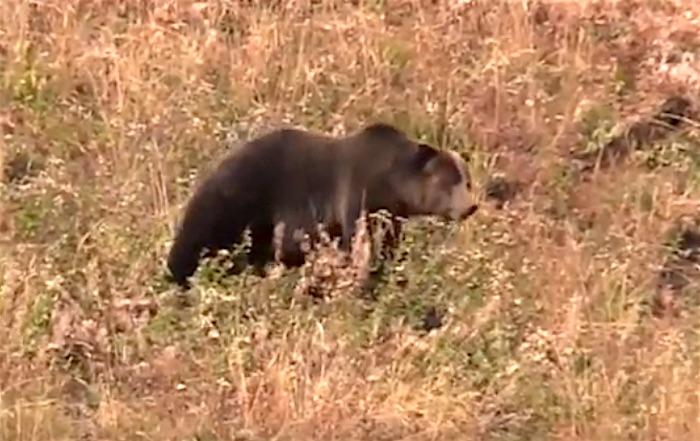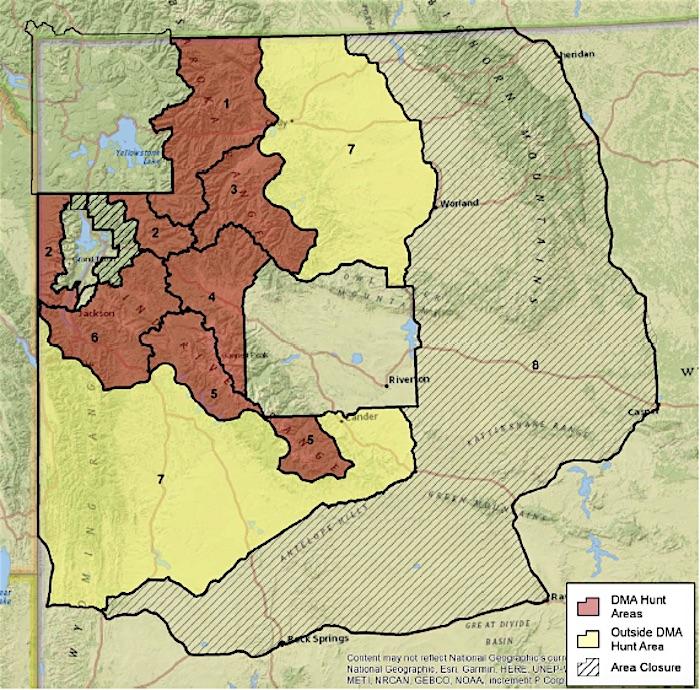
This grizzly bear was "shot" on a hillside in John D. Rockefeller, Jr. Memorial Parkway/Kurt Repanshek
I shot a grizzly bear in Wyoming last fall. And he survived.
My wife and I were heading home from a short stay in Yellowstone National Park, where we got in some great hikes and enjoyed the relative solitude you can find there in the waning weeks of the fall visitation season, and driving through John D. Rockefeller Jr. Memorial Parkway when we came up to a traffic jam. Pulling over and looking up on the hillside where a ranger was pointing, we easily picked out the grizzly bear foraging on the hillside.
I quickly jumped out, grabbed my camcorder, and did my best to keep it steady while slowly following the bear as it worked its way across the hillside.
While that grizzly survived the "shooting," the Wyoming Game and Fish Commission has given final approval to a different kind of shooting of nearly two dozen grizzlies. The fatal kind.
"Grizzly bears, including those that make their homes in and around Grand Teton and Yellowstone national parks, will be at risk from hunting this fall, for the first time in more than 40 years," said National Parks Conservation Association staff in lamenting the commission's action. "The hunt will include some female bears and targets lands adjacent to the national parks."
The commission viewed its approach to a hunt as "conservative."
“Many, many people have been part of this process since last fall in helping to set a direction for all grizzly bear management, from education, conflict reduction to hunting. Wyoming is committed to ensuring a recovered population to provide opportunity for anyone who is interested in grizzly bears and this decision is part of our management," said Scott Talbott, director of the Wyoming Game and Fish Department.
Parts of this approved plan that were based on public input include: mandatory education for grizzly bear hunters, hunt areas and regulations to direct harvest to areas with higher potential for grizzly bear/human conflicts, a closed portion of a hunt area next to Grand Teton National Park to support the wildlife viewing tourism economy and a prohibition against hunting grizzly bears near highways.
For those hoping to land a permit to hunt grizzlies, the cost for in-state residents is set at $602, and at $6,002 for out-of-state residents.
Under the plan, just one female grizzly would be allowed to be taken inside the Designated Monitoring Area, a zone rimming Yellowstone and Grand Teton national parks. After that kill, the area would be closed for the season. However, more bears could be taken outside of the DMA.

This map shows the Designated Monitoring Areas, in brown, around Yellowstone and Grand Teton national parks/NPCA
The commission's unanimous decision comes in spite of a pending lawsuit filed by a coalition of tribal and conservation groups in a bid to block the government's decision to remove Endangered Species Act protections from the bears.
“Visitors to Yellowstone and Grand Teton this summer may be among the last to experience the joy of seeing some of these incredible animals alive in our national parks. The grizzly bears that have gained international fame through the stories and photographs of park visitors regularly leave park borders and will be among those at risk this fall," said Bart Melton, NPCA's Northern Rockies regional director.
“National Parks Conservation Association was joined by nearly 40,0000 national park wildlife supporters who urged Governor (Matt) Mead to stop the proposal for the first grizzly hunt since 1975. This hunt follows a flawed removal of federal protections for the great bears that we fear will result in fewer bear sightings by visitors and increased risk for future of this species that was not so long ago at the brink of extinction.”
Mr. Melton said the commission's approach to hunting grizzlies seemed illogical.
"Wyoming is proposing to only allow one hunter at a time on the ground and to close the hunt inside the DMA once one female has been removed (we assume to protect the overall health of this slow reproducing species). We would prefer to see hunting moved away from the park, but we can at least appreciate their logic inside the DMA," he said. "Strangely, outside the DMA, this logic goes out the window. In fact, multiple female grizzlies could easily be killed in one day as multiple hunters will be allowed on the ground at the same time.
"One can only assume this is based on the stated belief of the Wyoming Game and Fish staff that grizzly bears outside the DMA don’t contribute to the Yellowstone population. This logic is faulty at best; grizzlies don’t recognize lines on maps, so when they cross the line from inside to outside the DMA Wyoming may view them as no longer contributing the larger population, but the fact is they do," he continued.
"A bear shot outside the DMA could easily spend the majority of its time inside the DMA, maybe even inside of Yellowstone or Grand Teton. Grizzlies are wide-ranging animals and to pretend they no longer exist or contribute to the Yellowstone population’s overall health when they cross a line on a map simply isn’t taking management of the species seriously."
Put another way, that grizzly that appears in the video above could wander outside the DMA and be killed even though it uses habitat inside John D. Rockefeller, Jr. Memorial Parkway and possibly Grand Teton or Yellowstone, too.
The Center for Biological Diversity also criticized the commission's action, saying it's too early in the grizzly bear's recovery to allow a hunt.
"Although grizzly bear numbers in the Greater Yellowstone area increased with endangered species protections granted in 1975, the bears continue to be threatened by isolation from other grizzly populations, loss of key food sources and human-caused mortalities, including, now, hunting. Overall grizzly bears occupy less than 4 percent of their historic U.S. range," the group noted.
“Yellowstone’s bears are national treasures. Hunting them is like defacing the Statue of Liberty or filling in the Grand Canyon,” said Noah Greenwald, the center's endangered species director. “Millions of people come to see these bears every year. It’s so disturbing that Wyoming thinks they’re more valuable dead than alive.”



Comments
"conservation"? NOT!
I have been hunting wildlife inside and outside of our national parks for years and this includes three trips to Yellowstone. However, I have always done it with the DSLR cameras that I own. Not only do I get some anazing and beautiful photos, but other people have the same opportunity. Best of all, the wildlife I hunt continues live and reproduce. Thus, guaranteeing the survival of the species for the enjoyment of future generations of visitors. This latest decision to support the hunting of grizzly bears is in my opinion shortsighted and wrong. The experience from similar decisions can result in seriously depleated populations of the species that is open to hunting and a lack of genetic diversity in the animals remaining. Obviously, this this changes the ecosystems in which these animals live, sometimes radically. For proof, one only has to look at wildlife extinction records in North America. Of course, I suppose we could teach the grizzlies to stay inside the areas where the can avoid being hunted. It certainly makes as much sense as the policy change allowing the great bears to be hunted.